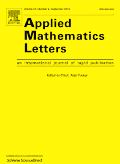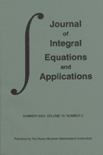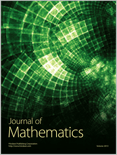
Advances in Difference Equations
Scope & Guideline
Driving Progress in Difference Equations and Beyond
Introduction
Aims and Scopes
- Mathematical Modeling and Analysis:
The journal emphasizes the creation and analysis of mathematical models, particularly in the context of differential and difference equations. This includes applications in biology, physics, and engineering, where models simulate real-world phenomena. - Stability and Oscillation Theory:
A significant focus is on the stability and oscillation criteria of various differential and difference equations. Researchers contribute findings on conditions that affect the stability of solutions, which is critical for understanding the behavior of dynamic systems. - Numerical Methods and Approximations:
The journal publishes work on numerical techniques and methods for solving both linear and nonlinear difference and differential equations. This includes innovative approaches to improve accuracy and efficiency in computational solutions. - Fractional Calculus:
There is a growing interest in the application of fractional calculus within the journal, addressing fractional differential equations and their unique properties, which have applications in various scientific fields. - Fixed Point Theory:
The journal explores fixed point theorems and their applications in solving differential equations, providing a theoretical foundation for ensuring the existence and uniqueness of solutions. - Applications in Epidemiology and Ecology:
Recent publications have increasingly focused on mathematical models relevant to epidemiology and ecological systems, reflecting the journal's commitment to addressing contemporary global challenges.
Trending and Emerging
- Fractional Differential Equations:
The interest in fractional differential equations has surged, with numerous papers exploring their properties, applications, and numerical solutions. This trend reflects a broader acceptance and application of fractional calculus in modeling complex systems. - Epidemiological Modeling:
A significant increase in publications related to epidemiological models, particularly in the context of COVID-19 and other infectious diseases. This reflects the urgent need for mathematical frameworks to inform public health responses. - Stochastic Models:
There is a growing trend towards incorporating stochastic elements in models, recognizing the inherent uncertainties in real-world systems. This includes stochastic differential equations that better capture dynamic behaviors in complex environments. - Multi-Scale and Multi-Dimensional Models:
Emerging research increasingly focuses on multi-scale and multi-dimensional models that can capture the interactions between various biological or ecological factors, reflecting a more holistic approach to mathematical modeling. - Numerical Analysis Techniques:
There has been a rise in innovative numerical methods and algorithms aimed at solving complex differential equations, showcasing advancements in computational mathematics and its applications.
Declining or Waning
- Traditional Differential Equations:
There has been a noticeable decline in publications focusing solely on classical differential equations without the integration of fractional or difference aspects, as the field moves towards more complex and nuanced models. - Single-Dimensional Models:
Research focusing exclusively on one-dimensional mathematical models appears to be decreasing, with a trend towards multi-dimensional and more complex systems that better represent real-world phenomena. - Static Models:
There is a waning interest in static or equilibrium models, with a shift towards dynamic models that incorporate time-dependent variables and interactions, particularly in biological and ecological contexts. - Purely Theoretical Contributions:
There has been less emphasis on purely theoretical contributions without practical applications, as the journal increasingly prioritizes research that demonstrates real-world relevance and application.
Similar Journals

Sahand Communications in Mathematical Analysis
Empowering researchers through open-access innovation.Sahand Communications in Mathematical Analysis is a distinguished open-access journal published by the University of Maragheh in Iran, dedicated to the field of mathematical analysis and its applied branches. Since its inception in 2014, the journal has provided a valuable platform for researchers to disseminate significant findings in areas ranging from analytical methods to numerical analysis and applied mathematics. Despite its relatively recent establishment, the journal has quickly gained recognition, noted for its Q3 rankings in both Applied Mathematics and Numerical Analysis categories, and its Q4 ranking in Analysis for 2023. With an ambition to foster innovative research and facilitate scholarly dialogue, Sahand Communications in Mathematical Analysis aims to support the global mathematical community by ensuring unrestricted access to high-quality research outputs. Researchers, professionals, and students can look forward to engaging content that pushes the boundaries of mathematical inquiry through its open-access model, thus enhancing the accessibility and reach of critical mathematical discussions.

Computational Methods for Differential Equations
Exploring Innovative Solutions in Differential EquationsComputational Methods for Differential Equations is a prominent academic journal dedicated to the exploration and application of computational techniques in the realm of differential equations. Published by UNIV TABRIZ, this open-access journal has been providing unrestricted access to groundbreaking research since 2013, making it a valuable resource for the global academic community, particularly in Iran. It has carved out a niche within the fields of Algebra and Number Theory, Applied Mathematics, and Numerical Analysis, maintaining a Q3 quartile ranking in 2023 across these categories. Researchers, professionals, and students alike will find the journal's commitment to disseminating innovative computational methodologies essential for advancing knowledge and developing robust solutions to complex mathematical problems. With its ISSN 2345-3982 and E-ISSN 2383-2533, the journal ensures wide visibility and accessibility, serving a diverse audience and promoting scholarly discourse.

Applied Mathematics Letters
Transforming Theoretical Insights into Practical ApplicationsApplied Mathematics Letters is a prestigious journal dedicated to the dissemination of significant research in the field of applied mathematics. Published by PERGAMON-ELSEVIER SCIENCE LTD in the United Kingdom, this journal serves as a vital resource for researchers, professionals, and students alike, aiming to bridge theoretical findings and practical applications. With an impressive impact factor placing it in the Q1 category and ranked 33 out of 635 in the Applied Mathematics category by Scopus, it showcases influential articles that contribute to advancements across various applications of mathematics. The journal's coverage from 1988 to 2025 ensures a rich archive of research that remains relevant and insightful for contemporary studies. Currently, it operates under a subscription-based model, providing access to cutting-edge research that forms the backbone of mathematical application in science and engineering. To become part of this dynamic community of scholars, readers are encouraged to explore the latest findings and ongoing discussions that highlight the interplay between mathematics and its real-world impacts.

ZEITSCHRIFT FUR ANGEWANDTE MATHEMATIK UND PHYSIK
Illuminating the Path of Discovery in STEM FieldsZEITSCHRIFT FUR ANGEWANDTE MATHEMATIK UND PHYSIK, published by Springer International Publishing AG, is a leading journal in the fields of applied mathematics and physics, highly regarded as evidenced by its prestigious Q1 rankings in 2023 across multiple categories, including Applied Mathematics, Mathematics (miscellaneous), and Physics and Astronomy (miscellaneous). With an ISSN of 0044-2275 and an E-ISSN of 1420-9039, this journal covers a broad spectrum of research from theoretical frameworks to practical applications, making it an indispensable resource for researchers, professionals, and students alike. With converged years running from 1950 to 2024, it offers a rich history of contributions to the scientific community and remains vital for current advancements in mathematics and physics. While not an open-access journal, its subscription model ensures high-quality, peer-reviewed content that fosters innovation and collaboration across disciplines. The journal is conveniently located in Cham, Switzerland, providing a central hub for global research dissemination in these critical areas of study.

DISCRETE AND CONTINUOUS DYNAMICAL SYSTEMS-SERIES B
Unraveling the Complexities of Dynamical SystemsDISCRETE AND CONTINUOUS DYNAMICAL SYSTEMS-SERIES B, published by the American Institute of Mathematical Sciences (AIMS), is a premier journal in the fields of Applied Mathematics and Discrete Mathematics and Combinatorics. With an ISSN of 1531-3492 and an E-ISSN of 1553-524X, the journal addresses significant advances in the mathematical sciences, particularly focusing on the analysis of dynamical systems through discrete and continuous approaches. As recognized in the 2023 Scopus ranks, it holds a commendable position, being classified in the Q2 category for both its mathematical domains, reflecting its high-quality publications and substantial impact on ongoing research. With a converged publication timeline from 2001 to 2025, the journal plays an essential role in facilitating innovative mathematical discourse, making it an invaluable resource for researchers, professionals, and students eager to explore the latest developments and applications in this dynamic field. Although specific open access options are not currently stated, the journal remains committed to disseminating valuable content for those passionate about the intricacies of mathematical systems.

Nonlinear Analysis-Modelling and Control
Innovating solutions through interdisciplinary collaboration.Nonlinear Analysis-Modelling and Control is a leading open-access journal published by the Vilnius University, Institute of Mathematics and Informatics, nestled in the heart of Lithuania. Since its inception in 2009, the journal has been committed to advancing the field of nonlinear analysis through rigorous research and comprehensive modelling techniques. With an impressive Q2 category ranking in both Analysis and Applied Mathematics for 2023, it stands out with its strong academic influence reflected in its Scopus ranking, where it is positioned in the top 12% percentile for Mathematics - Analysis and the top 24% for Mathematics - Applied Mathematics. This journal not only serves as a platform for pioneering research but also emphasizes interdisciplinary collaboration in addressing complex mathematical and control problems. Its open-access policy since 2017 ensures that its findings are readily accessible to a global audience, fostering knowledge dissemination and innovation across the mathematical community. Researchers, professionals, and students will find Nonlinear Analysis-Modelling and Control an essential resource for the latest developments and applications in nonlinear systems.

Journal of Integral Equations and Applications
Unraveling Complexities in Applied Mathematics.Journal of Integral Equations and Applications, published by the ROCKY MT MATH CONSORTIUM, is a pivotal resource in the field of Applied Mathematics and Numerical Analysis. With its inaugural issue released in 1988, this journal has consistently served as a platform for the dissemination of innovative research and comprehensive reviews pertinent to integral equations and their multifaceted applications. Although the journal currently does not offer an open access option, it boasts a competitive standing with a 2023 Scopus ranking that places it in the Q3 category for both Applied Mathematics and Numerical Analysis, emphasizing its significance among peer publications. The ISSN 0897-3962 and E-ISSN 1938-2626 ensure its accessibility to scholars seeking to advance their understanding in these critical areas. As it strides towards its convergence goals culminating in 2024, the Journal of Integral Equations and Applications remains an essential resource for researchers, professionals, and students eager to explore the theoretical and practical applications of integral equations.

Journal of Mathematics
Connecting scholars to shape the future of mathematics.Welcome to the Journal of Mathematics, a premier open access journal published by Hindawi Ltd, dedicated to advancing knowledge in the diverse realm of mathematics. Since its inception in 2013, the journal has provided a platform for the dissemination of significant mathematical research and applications, achieving recognition in the 80th percentile of the general mathematics category as per Scopus rankings. With a commitment to fostering academic collaboration and accessibility, the journal promotes critical dialogue among researchers, professionals, and students alike. Located in the vibrant academic hub of London, England, the Journal of Mathematics continues to enhance its impact within the mathematical community, as evidenced by its Q3 classification in mathematics (miscellaneous) for 2023. Join us in exploring groundbreaking research and innovations, as we converge towards the future of mathematical sciences through our open access model.

Punjab University Journal of Mathematics
Fostering innovation and dialogue in mathematics.Punjab University Journal of Mathematics is a prestigious academic journal published by the Department of Mathematics at the University of Punjab, Pakistan. Dedicated to advancing the field of mathematics, this journal provides a platform for researchers, educators, and students to disseminate their findings, foster scholarly dialogue, and promote innovative mathematical research. With a strong focus on theoretical and applied mathematics, the journal maintains a rigorous peer-review process to ensure high-quality publications that significantly contribute to the mathematical community. Although currently not indexed in prominent databases, the journal aims to elevate its visibility and impact through consistent publication of cutting-edge research. The absence of Open Access reflects a commitment to quality and thorough review, but researchers are encouraged to seek out this valuable resource for its insights and diverse contributions to mathematics.

Advances in Differential Equations
Advancing Mathematical Insights through Differential EquationsAdvances in Differential Equations is a premier journal that serves as a vital resource for researchers, professionals, and students in the fields of mathematics, particularly focusing on the theory and application of differential equations. Published by KHAYYAM PUBL CO INC, this journal has established itself as a key player in the academic landscape since its inception in 1996, with continuous contributions that bridge theoretical math and practical applications. With an impressive impact factor reflected in its category quartiles—ranking Q1 in Analysis and Q2 in Applied Mathematics for 2023—this journal is recognized for the quality and rigor of its published works. The journal's scope encompasses a wide array of topics, encouraging authors to submit innovative research that can advance the understanding of differential equations in various contexts. Although it does not operate as an Open Access journal, the subscription model ensures that readers receive high-quality, peer-reviewed research that contributes significantly to ongoing developments in mathematics. Based in the United States, Advances in Differential Equations continues to publish articles until 2024 and remains a crucial outlet for interdisciplinary collaboration and discourse in the mathematical sciences.